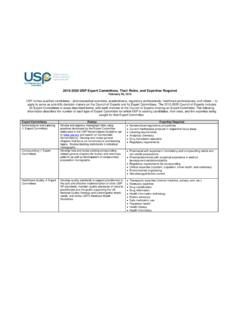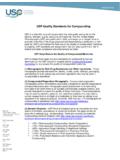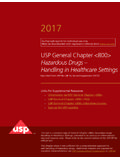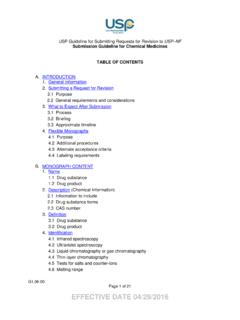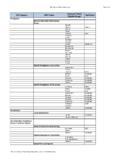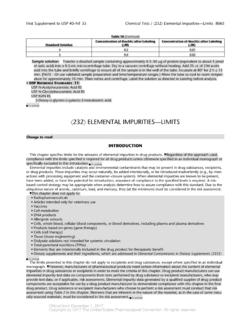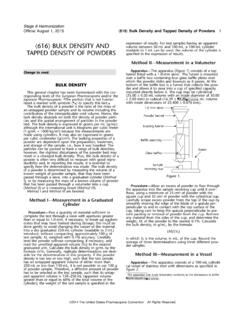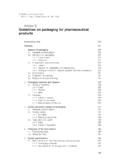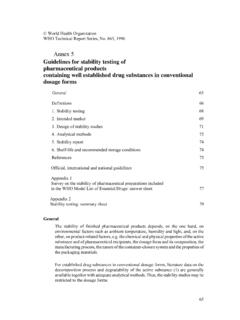Transcription of Mannitol - United States Pharmacopeia
1 Stage 6 Harmonization Official August 1, 2015 Mannitol 1.. Mode: LC. Detector: Refractive index Mannitol Column: 30-cm; packing L19. Temperatures Add the following: Column: 85 2 . Detector: 40 (maintain at a constant temperature). Portions of the monograph text that are national USP text, . Flow rate: mL/min and are not part of the harmonized text, are marked Injection volume: 20 L. with symbols ( ) to specify this fact. 2S (USP37).. Run time: NLT times the retention time of the Mannitol peak. [NOTE The retention time for manni- tol is about 20 min.]. System suitability Samples: System suitability solution A, System suitability solution B, Standard solution B, and Standard solution C. C6H14O6 Suitability requirements D- Mannitol [69-65-8]. Resolution: NLT between sorbitol and Mannitol , System suitability solution DEFINITION Analysis Samples: Standard solution A and Sample solution Calculate the percentage of Mannitol (C6H14O6) in the Change to read: portion of Mannitol taken: Mannitol contains NLT and NMT of man.
2 Result = (rU/rS) (CS/CU) 100. nitol (C6H14O6), calculated on the dried 1S (USP38) basis. rU = peak response from the Sample solution . 2S (USP37). rS = peak response from Standard solution A. IDENTIFICATION CS = concentration of USP Mannitol RS in Standard solution A (mg/mL). Change to read: CU = concentration of the Sample solution (mg/mL). Acceptance criteria: on the A. INFRARED ABSORPTION 197K dried 1S (USP38) basis 2S (USP37). If the spectra shows differences, proceed as directed.. IMPURITIES.. Standard solution: Dissolve 25 mg of USP Mannitol RS. in a glass vial with mL of distilled water without heating. The solution is clear. Evaporate to dryness by Change to read: one of the following methods. Heat in a microwave oven with a power range of 600 700 W for 20 min, or heat in an oven at 100 for 1 h, then gradually apply RELATED SUBSTANCES.
3 Vacuum until a dry residue is obtained. Non-sticky, Mobile phase, System suitability solution A, System white, or slightly yellowish powders are obtained. suitability solution B, Standard solution B, Standard Sample solution: Dissolve 25 mg of Mannitol in a solution C, Sample solution, Chromatographic sys- glass vial with mL of distilled water without heat- tem, and System suitability: Proceed as directed in ing. The solution is clear. Evaporate to dryness by one the Assay. of the following methods. Heat in a microwave oven Analysis with a power range of 600 700 W for 20 min, or heat Samples: Standard solution B, Standard solution C, and in an oven at 100 for 1 h, then gradually apply vac- Sample solution uum until a dry residue is obtained. Non-sticky, white, Acceptance criteria: See Table 1 for the relative reten- or slightly yellowish powders are obtained.
4 Tion times. Analysis: Record new spectra using the residues from the Standard solution and the Sample solution. 2S (USP37) Table 1. Relative ASSAY. Retention Name Time Change to read: Isomalt (1st peak) Maltitol PROCEDURE Isomalt (2nd peak) Mobile phase: Degassed water Mannitol . System suitability solution A: mg/mL each of sorbitol and USP Mannitol RS Sorbitol System suitability solution B: mg/mL each of mal- titol and isomalt [NOTE Impurity A Sorbitol; Impurity B Maltitol; Im- . Standard solution A: mg/mL of USP Mannitol RS purity C Isomalt.] 1S (USP38). Standard solution B: Dilute mL of the Sample solu- [NOTE Isomalt elutes in two peaks.]. tion with water to mL. [NOTE Coelution of impurity B and the second peak Standard solution C: Dilute mL of Standard solu- of impurity C may be observed.]
5 ]. tion B with water to mL. Disregard limit: NMT ; any peak NMT the area Sample solution: mg/mL of Mannitol of the principal peak obtained with Standard solution C. Chromatographic system Sorbitol: NMT ; NMT the area of the principal (See Chromatography 621 , System Suitability.) peak obtained with Standard solution B. Sum of isomalt and maltitol: NMT ; NMT the area of the principal peak obtained with Standard solu- tion B. 2014 The United States Pharmacopeial Convention All Rights Reserved. Stage 6 Harmonization 2 Mannitol Official August 1, 2015. Unspecified impurities: NMT for each impu- 2-pentanone), and then shake for 30 s protected from rity; NMT twice the area of the principal peak obtained bright light. Allow the layers to separate, and use the with Standard solution C methyl isobutyl ketone layer.
6 Total impurities: ; NMT the area of the principal Blank solution: Treat water-saturated methyl isobutyl peak obtained with Standard solution B 2S (USP37) ketone as described for preparation of the Sample solu- tion, omitting the Mannitol . Delete the following: Standard solutions: Prepare three reference solutions in the same manner as the Sample solution but adding CHLORIDE AND SULFATE, Chloride 221 .. , , and mL, respectively, of nickel standard Control: mL of N hydrochloric acid solution TS [10 ppm nickel (Ni)] in addition to the Sample: g g of the substance to be examined. Acceptance criteria: ; the Sample shows no Instrumental conditions more chloride than the Control. 2S (USP37) (See Spectrophotometry and Light-Scattering 851 .). Mode: Atomic absorption spectrophotometry Delete the following: Analytical wavelength: nm Lamp: Nickel hollow-cathode CHLORIDE AND SULFATE, Sulfate 221.
7 Flame: Air acetylene Control: mL of N sulfuric acid Analysis Sample: g Samples: Standard solutions and Sample solution Acceptance criteria: ; the Sample shows no Set the zero of the instrument using the blank. Re- more sulfate than the Control. 2S (USP37) cord the average of the steady readings for each of the Standard solutions and the Sample solution. Be- Delete the following: tween each measurement rinse with water, and as- certain that the reading returns to zero with the . ARSENIC, Method II 211 : NMT 1 ppm 2S (USP37).. blank. 1S (USP38) Plot the absorbances of the Standard solutions and the Sample solution versus the added quantity of nickel. Extrapolate the line joining the Change to read: points on the graph until it meets the concentration axis. The distance between this point and the inter- REDUCING SUGARS section of the axes represents the concentration of Copper sulfate solution: mg/mL of copper sul.
8 Nickel in the Sample solution. fate (CuSO4 5H2O) in water 1S (USP38).. Acceptance criteria: NMT 1 g/g 2S (USP37). Sodium potassium tartrate solution: Dissolve 173 g of sodium potassium tartrate (C4H4 KNaO6 4H2O) and SPECIFIC TESTS. 50 g of sodium hydroxide in 400 mL of water. Heat to boiling, allow to cool, and dilute with carbon dioxide- Change to read: free water to 500 mL. 1S (USP38).. Cupri-tartaric solution: Mix equal volumes of Copper MELTING RANGE OR TEMPERATURE, Class I 2S (USP37) 741 : sulfate solution and Sodium potassium tartrate solu- . 165 170 .. 2S (USP37). tion 1S (USP38) immediately before use.. Sample: g Delete the following: Analysis: To the Sample add 13 mL of water. Boil gen- tly with 40 mL of Cupri-tartaric solution for 3 min, and OPTICAL ROTATION, Specific Rotation 781S.
9 Allow to stand for about 2 min. A precipitate is formed.. Sample solution: Transfer 1 g of Mannitol to a 100-mL. Pass through a sintered-glass filter (10 16 m) coated volumetric flask, and add 40 mL of a 1-in-10 ammo- with diatomaceous earth or a sintered-glass filter (5 10 nium molybdate solution, previously filtered if neces- m). Wash the precipitate with hot water (at about sary. Add 20 mL of 1 N sulfuric acid, and dilute with 50 60 ) until the washing is no longer alkaline, and water to volume. pass the washings through the filter described above. Acceptance criteria: +137 to +145 2S (USP37). Discard all the filtrate at this step. Immediately dissolve the precipitate in 20 mL of ferric sulfate solution, pass Add the following: through the filter described above in a clean flask, and wash the filter with 15 20 mL of water.
10 Combine the APPEARANCE OF SOLUTION. washings and the filtrate, heat to 80 , and titrate with . Hydrazine sulfate solution: mg/mL of hydrazine M potassium permanganate VS. sulfate. Allow to stand for 4 6 h. Acceptance criteria: NMT , expressed as glucose; Methenamine solution: g of methenamine in NMT mL of M potassium permanganate VS is 25 mL of water, in a ground-glass-stoppered flask required to change the color of the solution. The green Primary opalescent suspension: To the Methenamine color turns to pink, and the color persists at least 10 s. solution, add mL of the Hydrazine sulfate solution. 2S (USP37) Mix, and allow to stand for 24 h. This suspension is stable for two months, provided it is stored in a glass Change to read: container free from surface defects. The suspension must not adhere to the glass and must be well mixed before use.
